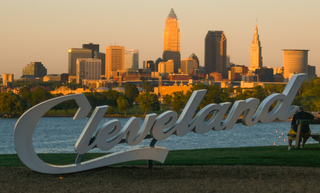
Cleveland, officially the City of Cleveland, is a city in the U.S. state of Ohio and the county seat of Cuyahoga County. Located in Northeast Ohio along the southern shore of Lake Erie, it is situated across the U.S. maritime border with Canada and lies approximately 60 miles (97 km) west of Pennsylvania.

The Greater Cleveland Regional Transit Authority is the public transit agency for Cleveland, Ohio, United States and the surrounding suburbs of Cuyahoga County. RTA is the largest transit agency in Ohio, with a ridership of 19,104,900, or about 67,300 per weekday as of the first quarter of 2023.

Terminal Tower is a 52-story, 235 m (771 ft), landmark skyscraper located on Public Square in Downtown Cleveland, Ohio, United States. Built during the skyscraper boom of the 1920s and 1930s, it was the second-tallest building in the world when it was completed. Terminal Tower stood as the tallest building in North America outside of New York City from its completion in 1927 until 1964. It was the tallest building in the state of Ohio until the completion of Key Tower in 1991, and remains the second-tallest building in the state. The building is part of the Tower City Center mixed-use development, and its major tenants include Forest City Enterprises, which maintained its corporate headquarters there until 2018, and Riverside Company.

Tower City Center is a large mixed-use facility in Downtown Cleveland, Ohio, on its Public Square. The facility is composed of a number of interconnected office buildings, including Terminal Tower, the Skylight Park mixed-use shopping center, Jack Cleveland Casino, Renaissance Cleveland Hotel, Chase Financial Plaza, and Tower City station, the main hub of Cleveland's four RTA Rapid Transit lines.

Downtown Cleveland is the central business district of Cleveland, Ohio. The economic and symbolic center of the city and the Cleveland-Akron-Canton, OH Combined Statistical Area, it is Cleveland's oldest district, with its Public Square laid out by city founder General Moses Cleaveland in 1796.

Public Auditorium is a multi-purpose performing arts, entertainment, sports, and exposition facility located in the civic center district of downtown Cleveland, Ohio. The 10,000-capacity main auditorium shares its stage with a second venue housed at the facility: the 3,000-capacity Music Hall. Although Public Auditorium was planned and funded prior to World War I, construction did not begin until 1920, and the building did not open until 1922. Designed by city architect J. Harold McDowell and Frank Walker of Walker and Weeks in a neoclassical style matching the other Group Plan buildings, it was the largest of its kind when opened, then seating 11,500.

The Justice Center Complex is a building complex located in the Civic Center District in Cleveland, Ohio, in the United States. The complex consists of the Cleveland Police Headquarters Building, the Cuyahoga County and Cleveland Municipal Courts Tower, and the Correction Center, and Jail II. It occupies a city block bounded by Lakeside Avenue, Ontario Street, West 3rd Street, and St. Clair Avenue. The Lakeside Avenue entrance faces the Cuyahoga County Court House, erected in 1912.

Public Square is the central plaza of Downtown Cleveland, Ohio. Based on an 18th-century New England model, it was part of the original 1796 town plat overseen by city founder General Moses Cleaveland of the Connecticut Land Company. The historical center of the city's downtown, it was added to the National Register of Historic Places in 1975.
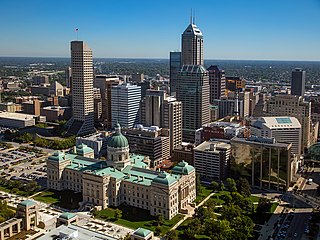
Downtown Indianapolis is a neighborhood area and the central business district of Indianapolis, Indiana, United States. Downtown is bordered by Interstate 65, Interstate 70, and the White River, and is situated near the geographic center of Marion County. Downtown has grown from the original 1821 town plat—often referred to as the Mile Square—to encompass a broader geographic area of central Indianapolis, containing several smaller historic neighborhoods.
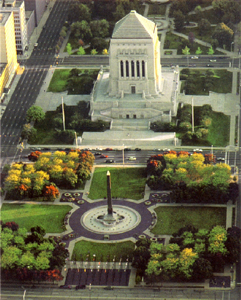
The Indiana World War Memorial Plaza is an urban feature and war memorial located in downtown Indianapolis, Indiana, United States, originally built to honor the veterans of World War I. It was conceived in 1919 as a location for the national headquarters of the American Legion and a memorial to the state's and nation's veterans.

The Cuyahoga County Courthouse stretches along Lakeside Avenue at the north end of the Cleveland Mall in downtown Cleveland, Ohio. The building was listed on the National Register along with the mall district in 1975. Other notable buildings of the Group Plan are the Howard M. Metzenbaum U.S. Courthouse designed by Arnold Brunner, the Cleveland Public Library, the Board of Education Building, Cleveland City Hall, and Public Auditorium.
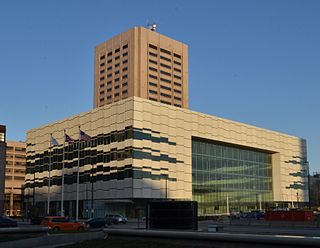
The Global Center for Health Innovation, also known as the Medical Mart, was a $465 million joint venture by Cuyahoga County and MMPI to construct a permanent showroom of medical, surgical and hospital goods along with a new Huntington Convention Center of Cleveland in downtown Cleveland, Ohio. Construction of the project on the historic Mall began May 2011 after being funded by a decades long 0.25% sales tax increase passed by Cuyahoga County commissioners in 2007. The Medical Mart concept is modeled after that of the Merchandise Mart in Chicago, and was initially managed by MMPI, the same company that operates the Merchandise Mart. SMG was scheduled to assume management of the Global Center on November 15, 2013. The Global Center closed in 2020 and remained vacant except for space temporarily leased on the 4th floor to accommodate socially distanced Cuyahoga County Common Pleas Court jury trials during the pandemic. In September of 2022, the Cuyahoga County Council approved a $40.4 million renovation to turn the Global Center for Health Innovation into an extension of the Huntington Convention Center of Cleveland.

The Howard M. Metzenbaum U.S. Courthouse is a historic courthouse and post office building located on Superior Avenue in downtown Cleveland, Cuyahoga County, Ohio. Its west side faces Public Square and its north side faces The Mall. It was formerly the Federal Building and U.S. Courthouse and also known as Old Federal Building and Post Office.
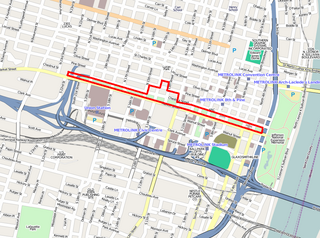
The Gateway Mall in St. Louis, Missouri is an open green space running linearly, one block wide, from the Gateway Arch at Memorial Drive to Union Station at 20th Street. Located in the city's downtown, it runs between Market Street and Chestnut Street.

This article is a timeline of the history of the city of Cleveland, Ohio, USA.

The Hilton Cleveland Downtown Hotel(HCDH) is a skyscraper on the corner of Ontario Street and Lakeside Avenue along The Mall in downtown Cleveland, Ohio, United States. It opened in 2016, has 600 rooms and is 32 stories high. It is one of four Hilton properties in downtown Cleveland, the other three being Hilton Garden Inn, the DoubleTree Hotel Cleveland, and Hampton Inn.

The Civic Center is a mostly governmental district in downtown Cleveland, Ohio that is home to the 1916 erected Cleveland City Hall Building. The 1925 Cleveland Public Library main branch, the 1976 massive Cuyahoga County Justice Center, the 419 foot Anthony J. Celebrezze Federal Building, the Federal Reserve Bank of Cleveland, the historic Cuyahoga County Courthouse, the Cleveland Public Hall, the Howard M. Metzenbaum U.S. Courthouse which abuts Public Square, and the city-owned greenspace Willard Park which is home to the Free Stamp.
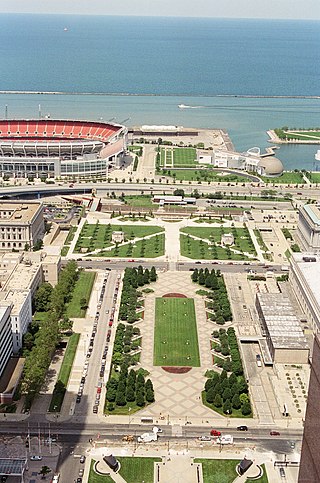
The Cleveland Convention Center was located in downtown Cleveland, Ohio. Built by the city of Cleveland beneath the Cleveland Mall adjacent to Public Auditorium, it was completed in 1964. Plans for the convention center were first made in 1956, but voters twice rejected initiatives to fund construction before approving a bond levy in November 1963. A local private foundation donated several million dollars to beautify the mall atop the convention center with a reflecting pool and fountains.

The Huntington Convention Center of Cleveland is a convention center located in downtown Cleveland, Ohio, in the United States. Built by Cuyahoga County, Ohio, beneath the Cleveland Mall, it opened on June 7, 2013. The older Cleveland Convention Center, built in 1964, was demolished to make way for the new structure.























